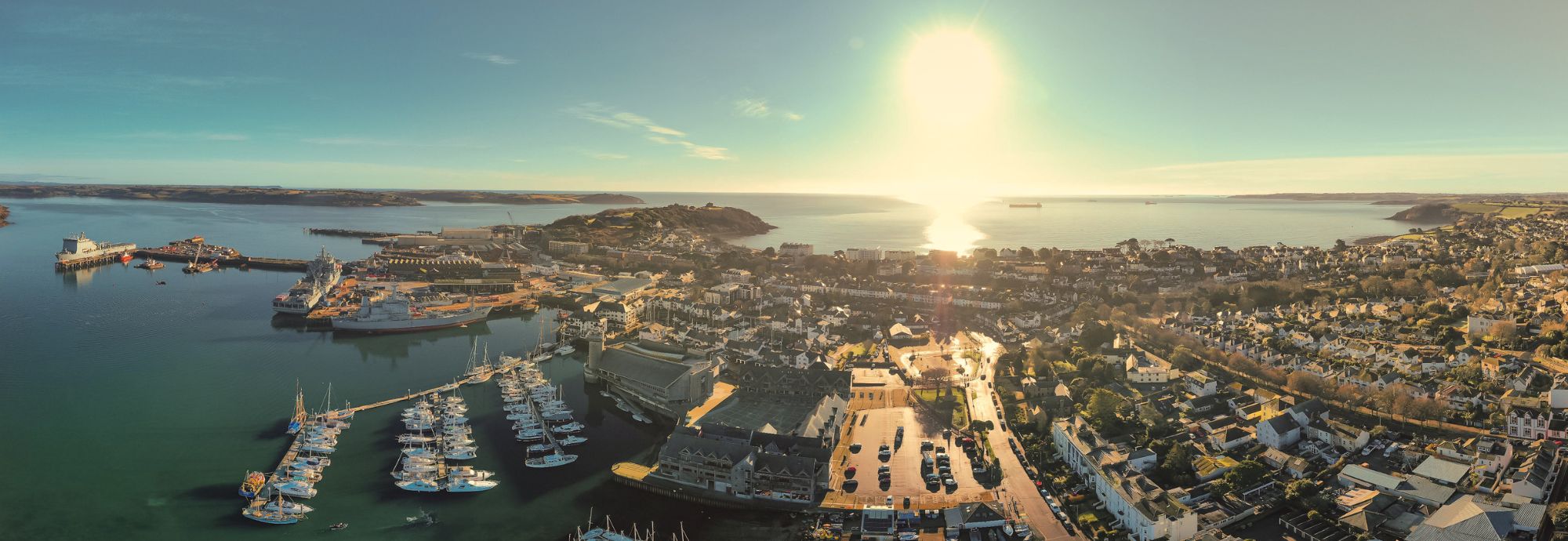

By Lynne Vosper
Falmouth is the UK’s first and last major port, located at the entrance to the Western Approaches. As the third deepest natural harbour in the world after Rio de Janeiro and Sydney, and the deepest in Western Europe, it is strategically located for the beginning or end of many important local, national and international events.
The following monuments, memorials and plaques around Falmouth’s historic harbour relate to the history of the town and can be viewed on a walk through the town. This is part one of a two-part series – keep an eye out for the second instalment later this month.
Starting from The Moor:
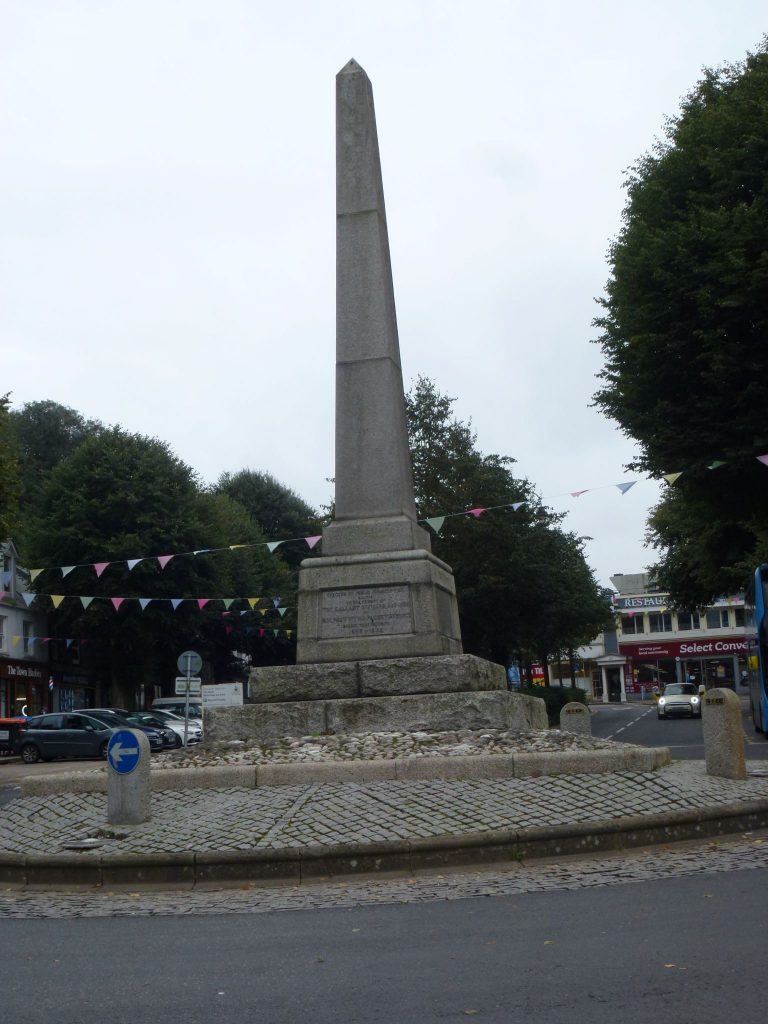
The Packet Memorial on The Moor ©LM Vosper
In 1688 the Post Office chose Falmouth as a packet station for handling overseas mail. Falmouth was chosen because sailing ships could enter and leave the harbour at all stages of the tide, by day or night and almost all weathers, and had almost direct access to the Atlantic, being the first and last port. This led to the building of a special fleet of fast, lightly armed ships known as Falmouth Packets, and the heroics of packet captains, such as John Bull. The memorial is situated on The Moor, in the town centre.
The Packet Memorial dates from November 1898, when funds had been raised by public subscription to build a permanent reminder of the service which operated from Falmouth. Carnsew Quarry in Mabe provided the 60 tons of granite for the monument and the Penryn company, Messrs Freeman & Co were awarded the contract to build it. The 38-ft high granite obelisk on the Moor, dedicated to the officers and men of the Packet Service, was unveiled on 19 November 1898 by Admiral Sir Edmund Freemantle with much pomp and ceremony.
Local historian, Peter Gilson, in his book ‘Falmouth in Old Photographs’, records that in 1897 a committee was formed for the purpose of raising funds for the monument. Unfortunately, the final date on the memorial was mistakenly recorded by the Committee as 1852 when it should be 1851.
The inscription reads:
ERECTED BY PUBLIC SUBSCRIPTION
AD 1898
TO THE GALLANT OFFICERS AND MEN
OF
HM POST OFFFICE PACKET SERVICE
SAILING FROM FALMOUTH
1688-1852
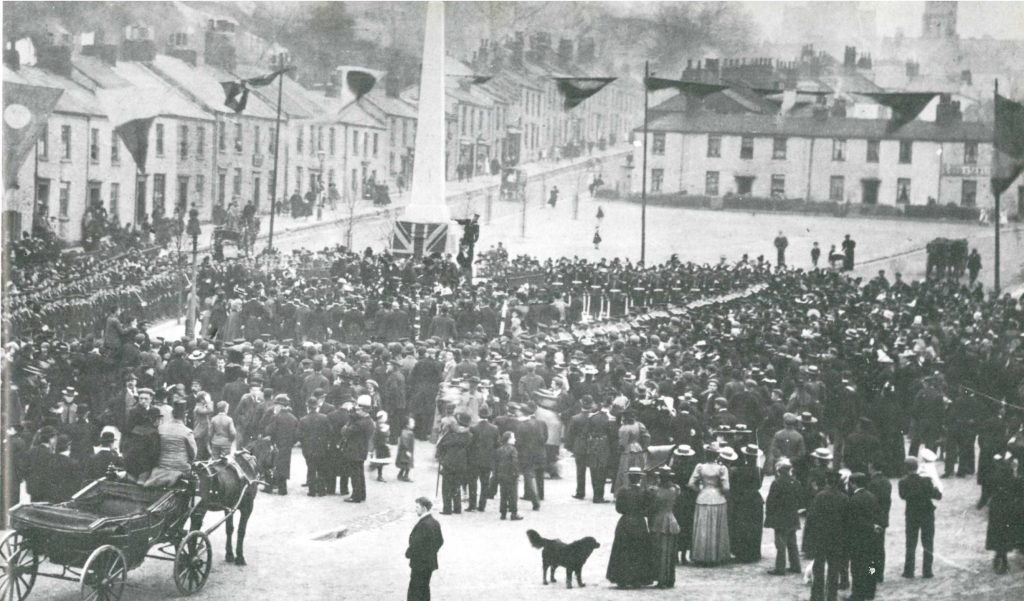
The unveiling of the Packet Memorial, 19 November 1898.
(Yesterday and Today around Falmouth and Penryn by Fisher Barham)
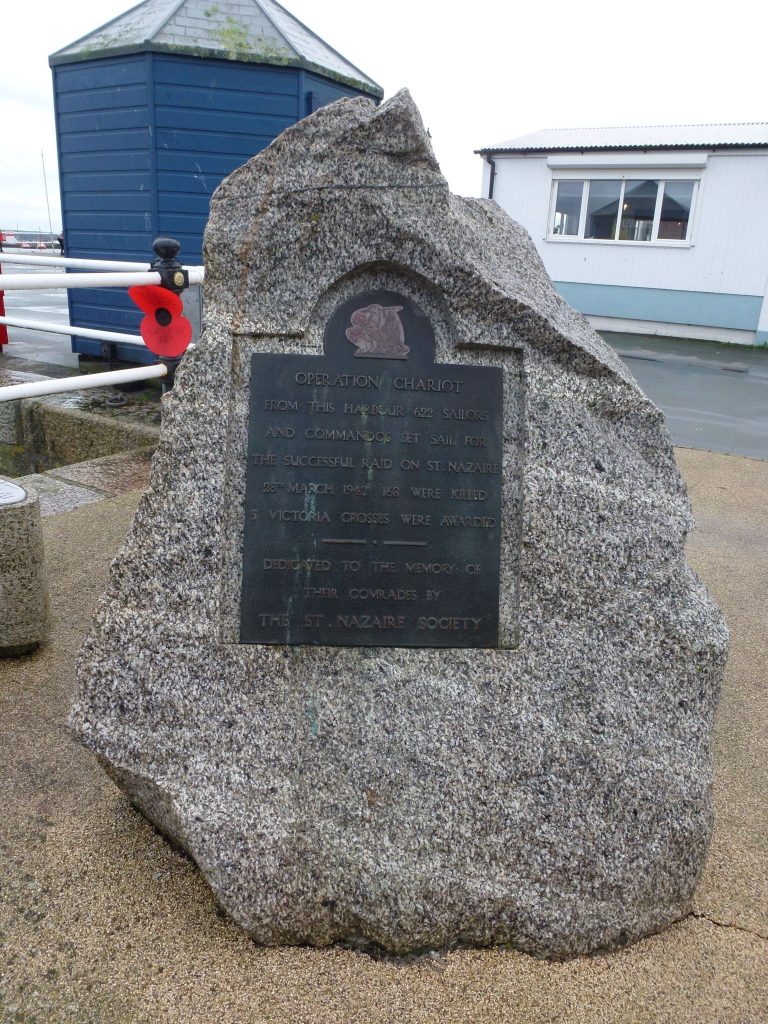
The St Nazaire Memorial on Prince of Wales Pier ©LM Vosper
The inscription reads:
OPERATION CHARIOT
FROM THIS HARBOUR 622 SAILORS
AND COMMANDOS SET SAIL FOR
THE SUCCESSFUL RAID ON ST NAZAIRE
28TH MARCH 1942. 168 WERE KILLED
5 VICTORIA CROSSES WERE AWARDED
DEDICATED TO THE MEMORY OF
THEIR COMRADES BY
THE ST NAZAIRE SOCIETY
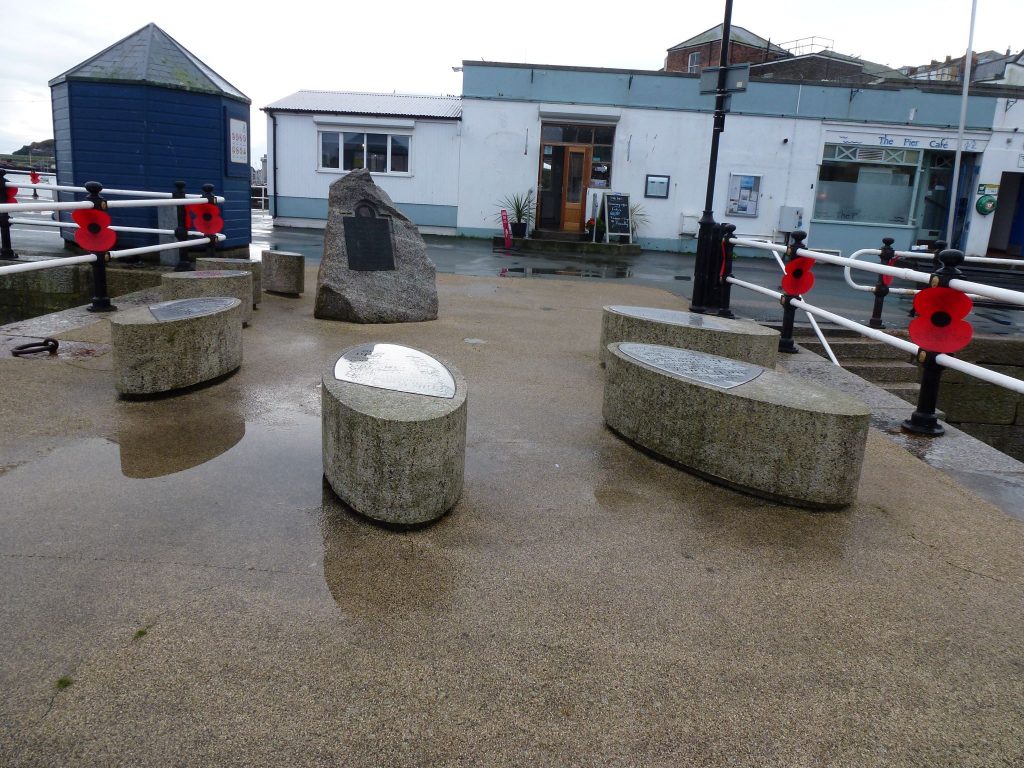
The St Nazaire Memorial on Prince of Wales Pier ©LM Vosper
Granite boulder and plaque surrounded by seven oval granite blocks.
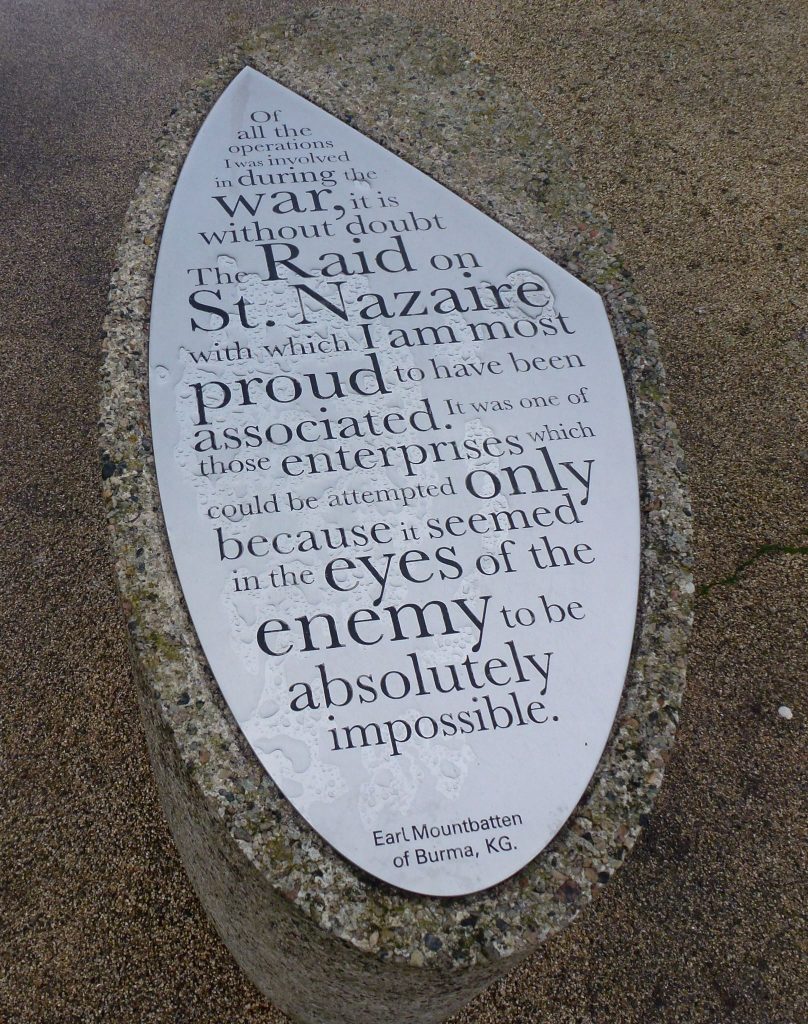
One of the oval granite blocks at the St Nazaire Memorial on Prince of Wales Pier ©LM Vosper
In July 1941, when it was realised that if the powerful German battleship Tirpitz could be prevented from dry-docking on the western Atlantic coast, she would have to return to her home ports, the seed was sown to destroy the Normandie Dock at St Nazaire, the only graving dock large enough to take the ship. The secret plans for Operation Chariot proceeded and in early 1942 when Admiral Mountbatten became Chief of Combined Operations final plans were drawn up for what became known as ‘The Greatest Raid of All’.
An old obsolete American destroyer, ex-DD131 USS Buchanan, renamed HMS Campbeltown, was chosen to be sacrificed in the raid. Before arriving in Falmouth, she was converted at Devonport Dockyard from a ‘four-stacker’ to present the silhouette of a German Wolf Class destroyer and would fly the German colours on the approach. HMS Campbeltown arrived in Falmouth on 23 March 1942 with two ‘Hunt’ class destroyers that were to act as escort ships, helping to protect the raiding party as they made their way to St Nazaire.
At 2pm on 26 March 1942, more than 600 men sailed from Falmouth in a flotilla of 16 motor launches, one MGB (motor gun boat), one MTB (motor torpedo boat) plus two destroyers, the HMS Atherstone and HMS Tynedale and HMS Campbeltown, which had been packed with five tons of high explosives and 24 depth charges. They were heading for the dry docks in the French town of St Nazaire on the north bank of the Loire, with the goal of destroying the dry dock complex and preventing the German battleship ‘Tirpitz’ from using the port as a base to attack enemy shipping in the North Atlantic. On 28 March, hundreds of Commandos stormed ashore, destroying dock installations. HMS Campbeltown rammed the dock gates of the Normandie Dock at 20 knots and exploded within hours taking the port out of action for the rest of the war.
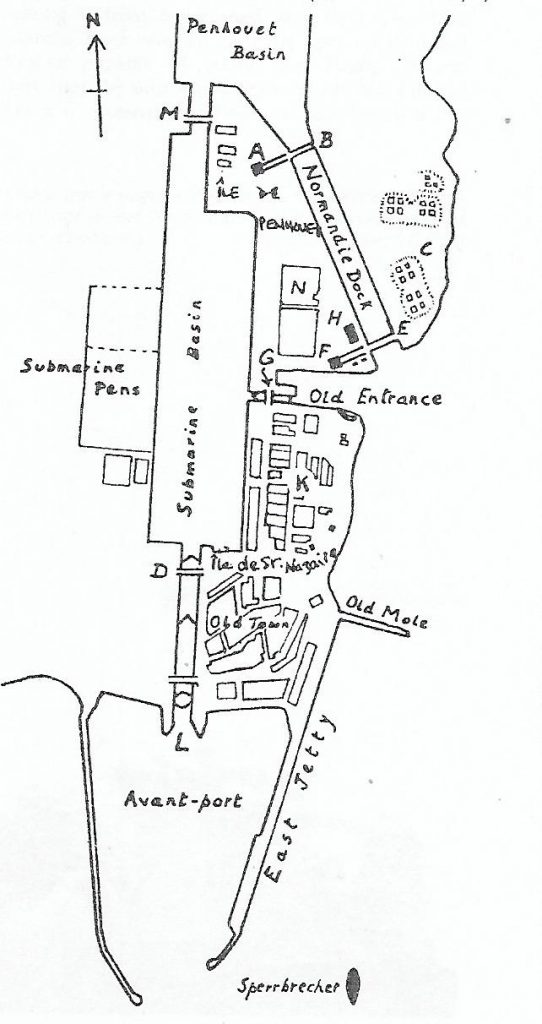
Diagram of the port and docks at St Nazaire. The Normandie Dock could dock an 85,000-ton ship.
(CF Lucas Phillips), in Warship Profile 5, HMS Campbeltown (USS Buchanan)
Copy held at the Bartlett Maritime Research Centre and Library, NMMC
Of the 611 men who took part in the raid, only 228 men returned with 169 killed and 215 captured by the Germans. Of the 18 ML’s who had set out on the raid, only four returned to Falmouth.
The raid led to the awarding of the following honours:
National Maritime Museum Cornwall is privileged to house a small display of artefacts belonging to Lieutenant Commander Beattie relating to the St Nazaire Raid.
Members of the St Nazaire Society visit Falmouth each year to commemorate the anniversary of the famous Second World War Commando Raid.
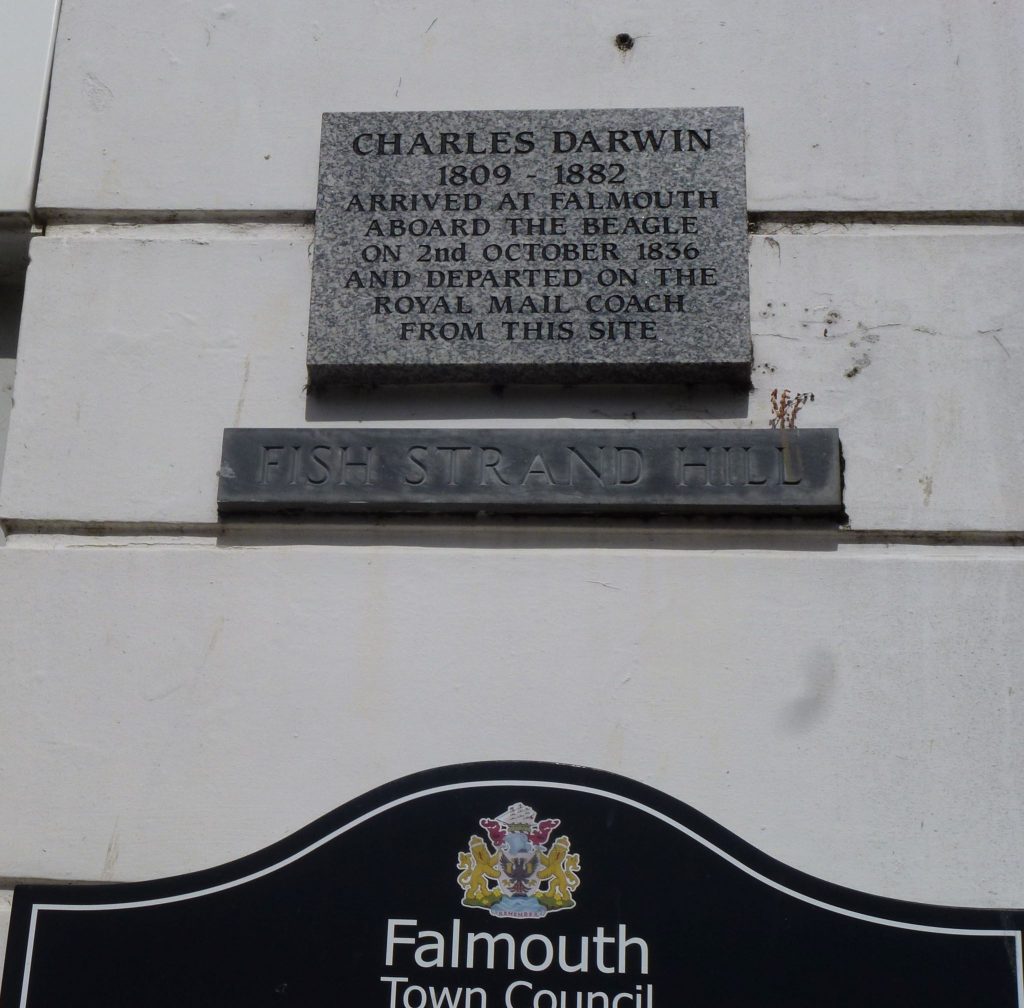
Charles Darwin Plaque ©LM Vosper
On 2 October 1836, the British naturalist, Charles Darwin, arrived in Falmouth Harbour aboard HMS Beagle following a five-year expedition of the southern Atlantic and Pacific oceans visiting places such as Brazil, the Galapagos Islands and New Zealand. It was this voyage that inspired his theory of evolution.
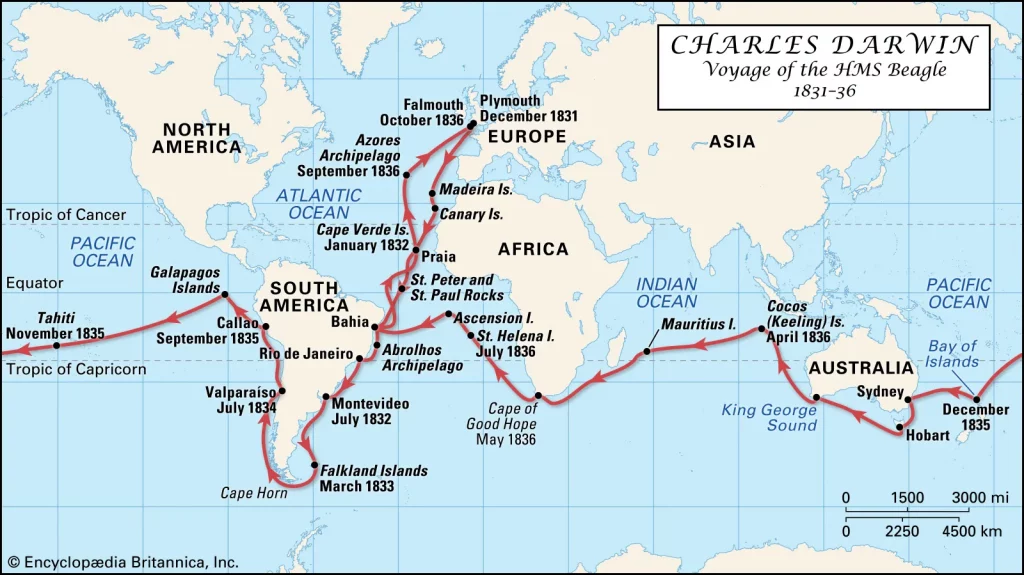
©Encyclopaedia Britannica, Inc.
Extensive research carried out by Falmouth Art Gallery volunteers in 2008-2009 located the exact spot from where Charles Darwin departed. It is believed that Darwin arrived here at about 9pm then spent a short amount of time at the Royal Hotel, before leaving Falmouth at about 11.30pm on the Royal Mail coach.
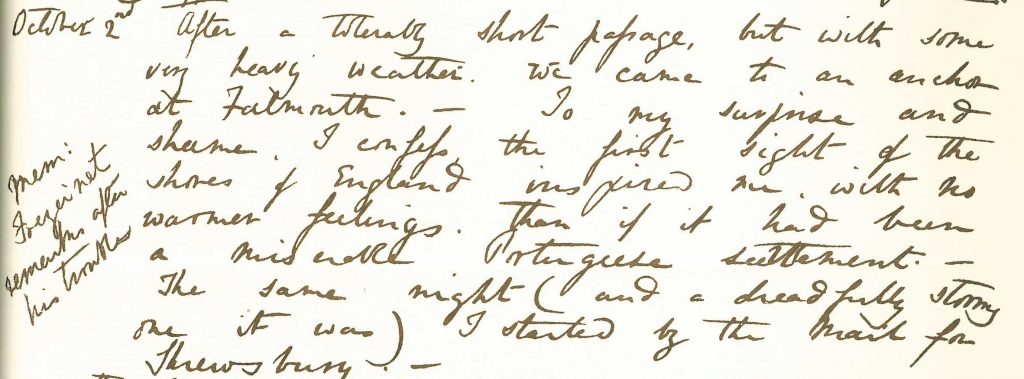
Transcription of an entry in the facsimile copy of ‘The Journal of a Voyage in HMS Beagle, Charles Darwin, 1831-1836’ held at the Bartlett Maritime Research Centre and Library, NMMC.
“2nd October 1836
After a tolerably short passage, but with some very heavy weather, we came to an anchor at Falmouth. To my surprise and shame, I confess the first sight of the shores of England inspired me with no warmer feelings than if it had been a miserable Portuguese settlement. The same night (and a dreadfully stormy one I was) I started by mail for Shrewsbury”.
The Cornish granite plaque is situated on the corner of Market and Fish Strand Hill, looking down to Falmouth Harbour. The plaque was commissioned by the Art Gallery and was designed and fitted by local monumental mason Robert Lawrence.
The inscription reads:
CHARLES DARWIN
1809-1882
ARRIVED AT FALMOUTH
ABOARD THE BEAGLE
ON 2ND OCTOBER 1836
AND DEPARTED ON THE
ROYAL MAIL COACH
FROM THIS SITE

Facsimile copy of ‘The Journal of a Voyage in HMS Beagle, Charles Darwin, 1831-1836’ held at the Bartlett Maritime Research Centre and Library ©LM Vosper
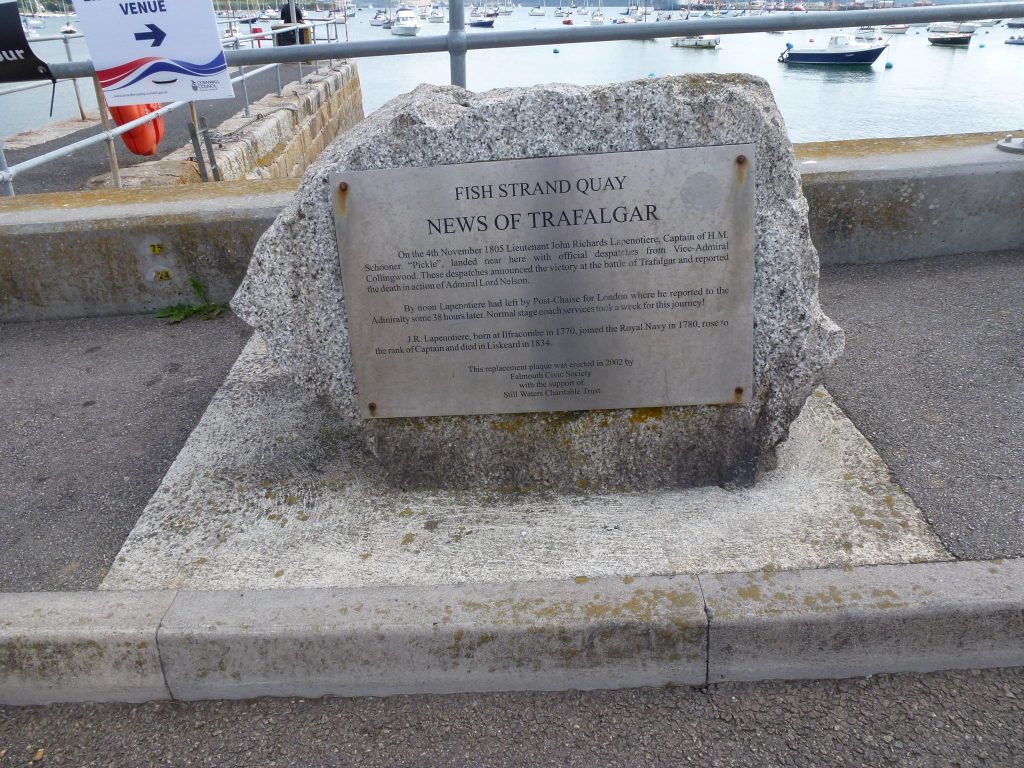
News of Trafalgar Memorial ©LM Vosper
The inscription reads:
FISH STRAND QUAY
NEWS OF TRAFALGAR
On the 4th November 1805 Lieutenant John Richards Lapenotiere, Captain of HM Schooner “Pickle” landed near here with official despatches from Vice-Admiral Collingwood.
These despatches announced the victory at the battle of Trafalgar and reported the death in action of Admiral Lord Nelson.
By noon Lapenotiere had left by Post-Chaise for London where he reported to the Admiralty some 38 hours later. Normal stagecoach services took a week for this service!
JR Lapenotiere, born at Ilfracombe in 1770, joined the Royal Navy 1780, rose to the rank of Captain and died in Liskeard in 1834.
This replacement plaque was erected in 2002 by
Falmouth Civic Society
with the support of
Still Waters Charitable Trust
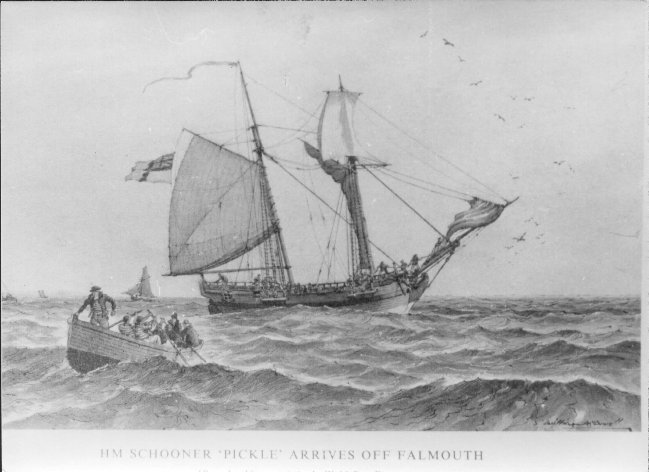
Image from Bartlett Maritime Research Centre and Library Collection
Black and white picture of HM Schooner ‘Pickle’ arriving at Falmouth in 1805,
Reproduced from a painting by William McDowell.
On Monday 21 October 1805 the Royal Navy defeated a combined French and Spanish fleet off Cape Trafalgar on the southwest coast of Spain. On 26 October 1805, Captain Lapenotiere of HM Schooner Pickle received written orders from Vice Admiral Collingwood to deliver the news of the victory at the Battle of Trafalgar and of the death of Nelson to the Admiralty and ultimately King George III. Lapenotiere set off immediately and after encountering severe weather finally reached Falmouth on 4 November 1805, where he was rowed ashore. After arriving in Falmouth, he set off for London by post-chaise to deliver the urgent despatches to the Admiralty and took some 37 hours to cover the 271-mile journey, changing horses 21 times and arriving at the Admiralty at 1am on Wednesday 6 November. The total cost of this journey was £46 19s 1d. The route that Lapenotiere took is now known as the Trafalgar Way.
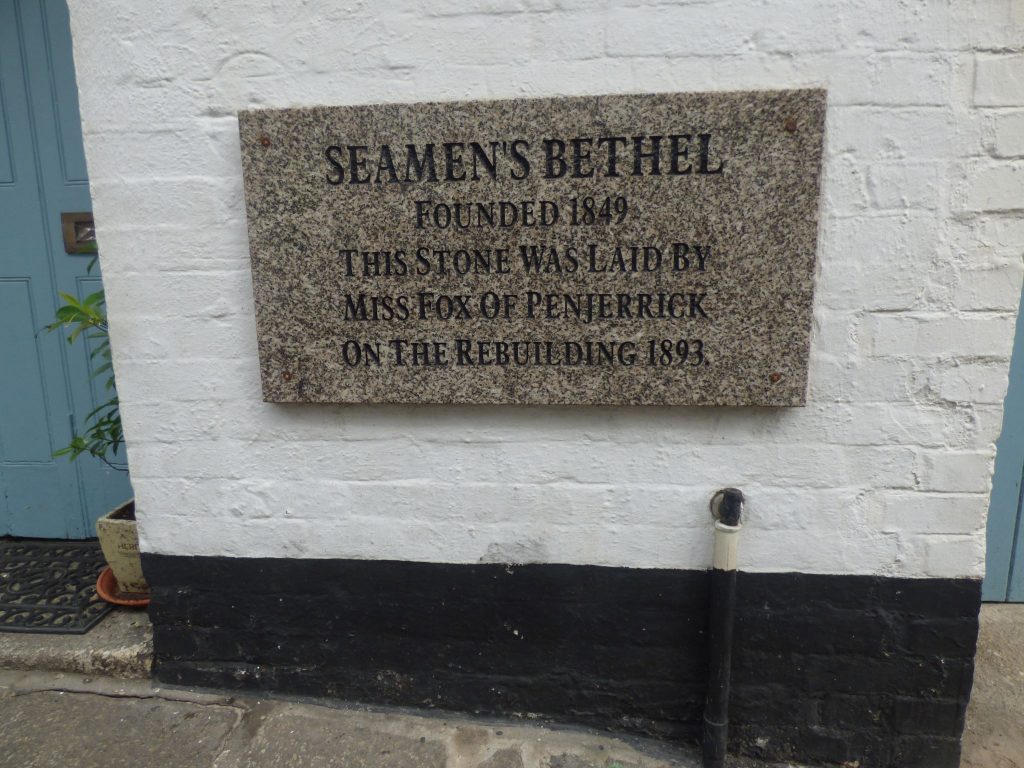
The Seamen’s Bethel Plaque. ©LM Vosper
This stone plaque records this building was formerly a “seamen’s bethel” where visiting seamen could be given a Christian welcome to Falmouth. The Bethel was founded in 1849 and was rebuilt in 1893 and is on the north side of Quay Hill. Miss Fox is most likely Anna Maria Fox (1816-1897), (Foxlinks.com).
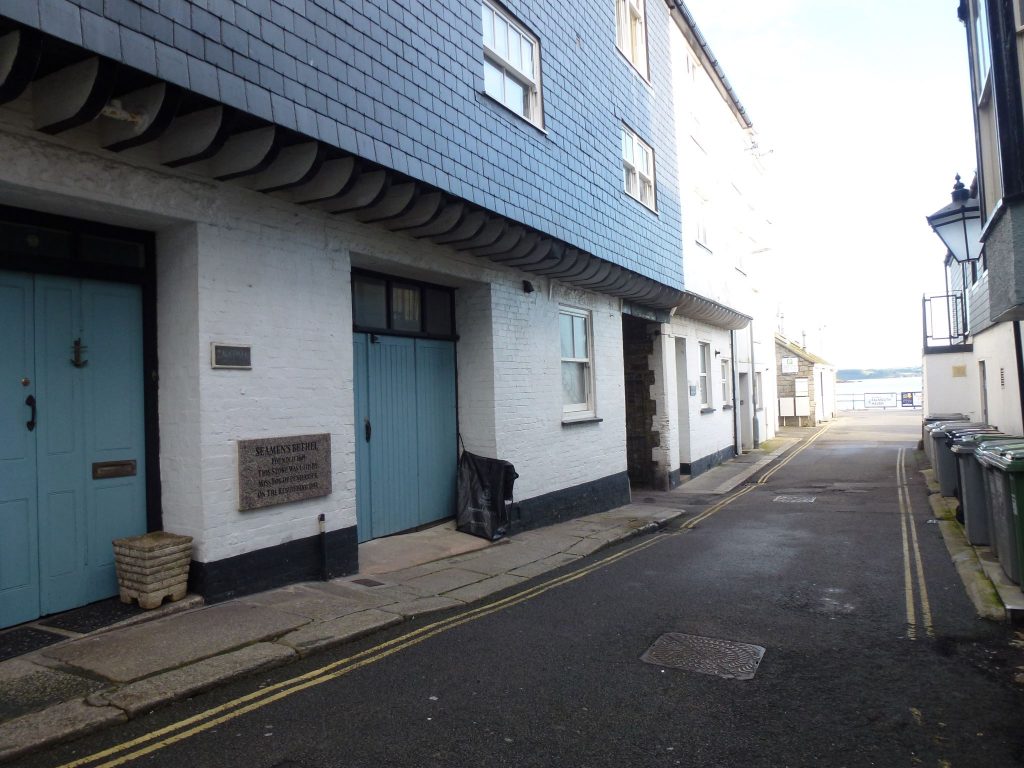
Site of The Seamen’s Bethel Plaque, Quay Hill ©LM Vosper
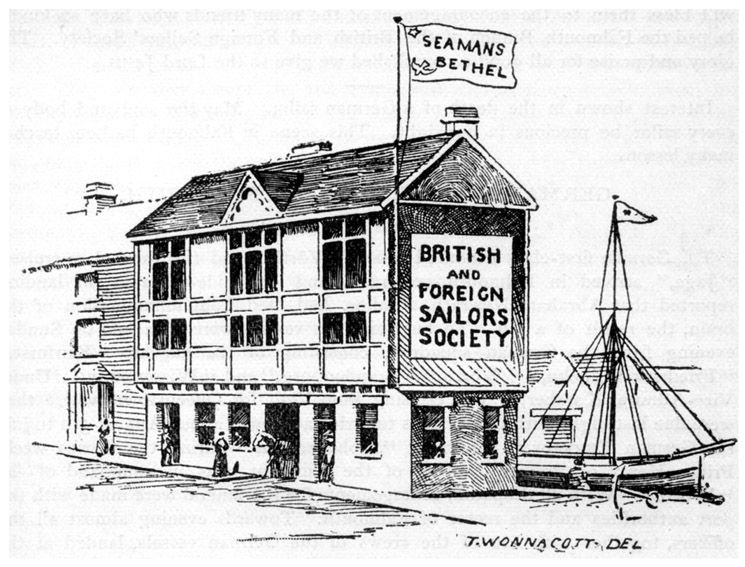
Drawing of Falmouth Seamen’s Bethel (British and Foreign Sailors Society)
Source: Chart & Compass Sailors Magazine 17 (1895)
From ‘The Maritime History of Cornwall’, copy held at The Bartlett
In 1847, a year of European famine, the West Briton newspaper reported in September that the harbour had for the previous week “upwards of 200 sail of merchantmen” mainly with corn and “waiting for orders”. In the early 1850s it was estimated that around 2,000 ships and 24,000 seamen were visiting Falmouth annually.
An entry in Kelly’s Directory 1910 records “There is a Seamen’s Bethel and Institute on Quay Hill, established in 1849, and rebuilt in 1893. It contains a mission room holding 700 persons and three large reading rooms and coffee bar for seafaring persons; a mission boat for harbour and roadstead work was presented to the Institution in November 1896”.
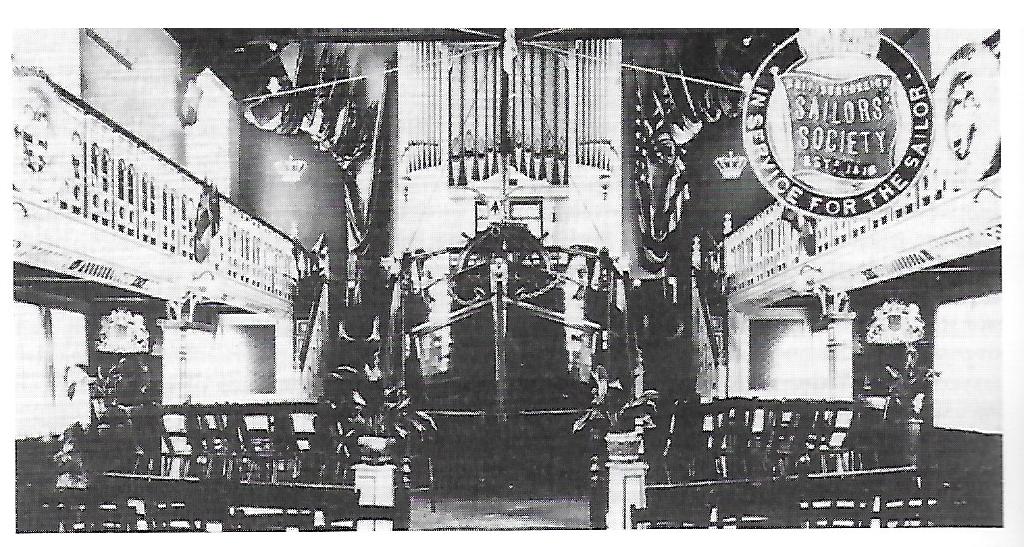
This photograph shows the unique ship’s bow pulpit for which the Bethel was best known, fitted with port and starboard lights, and dedicated to the memory of King Edward VII. The pulpit hides the bellows of the organ.
(Image from ‘The Lower Fal in Old Photographs’ by Peter Gilson)
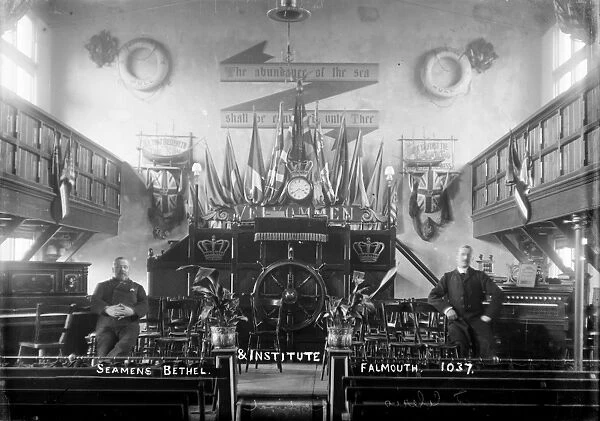
Interior of the Seamen’s Bethel and Institute, founded by the British and Foreign Sailors Society in 1849. Two men are pictured seated by a piano and an organ. There is a pulpit behind them backed by flags and a clock topped with a crown. Life rings from the ship Mohegan of Hull are hung on the wall.
(Photographer Arthur Philp). © RIC Royal Cornwall Museum
The building is now in residential use.
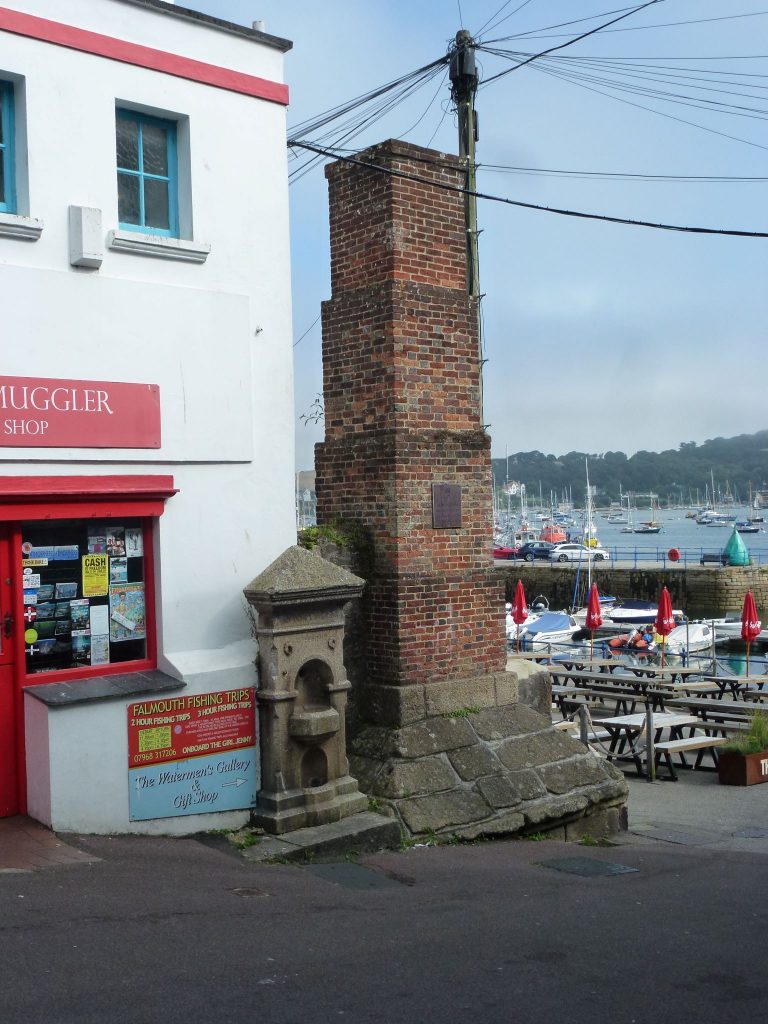
The King’s Pipe, Custom House Quay ©LM Vosper
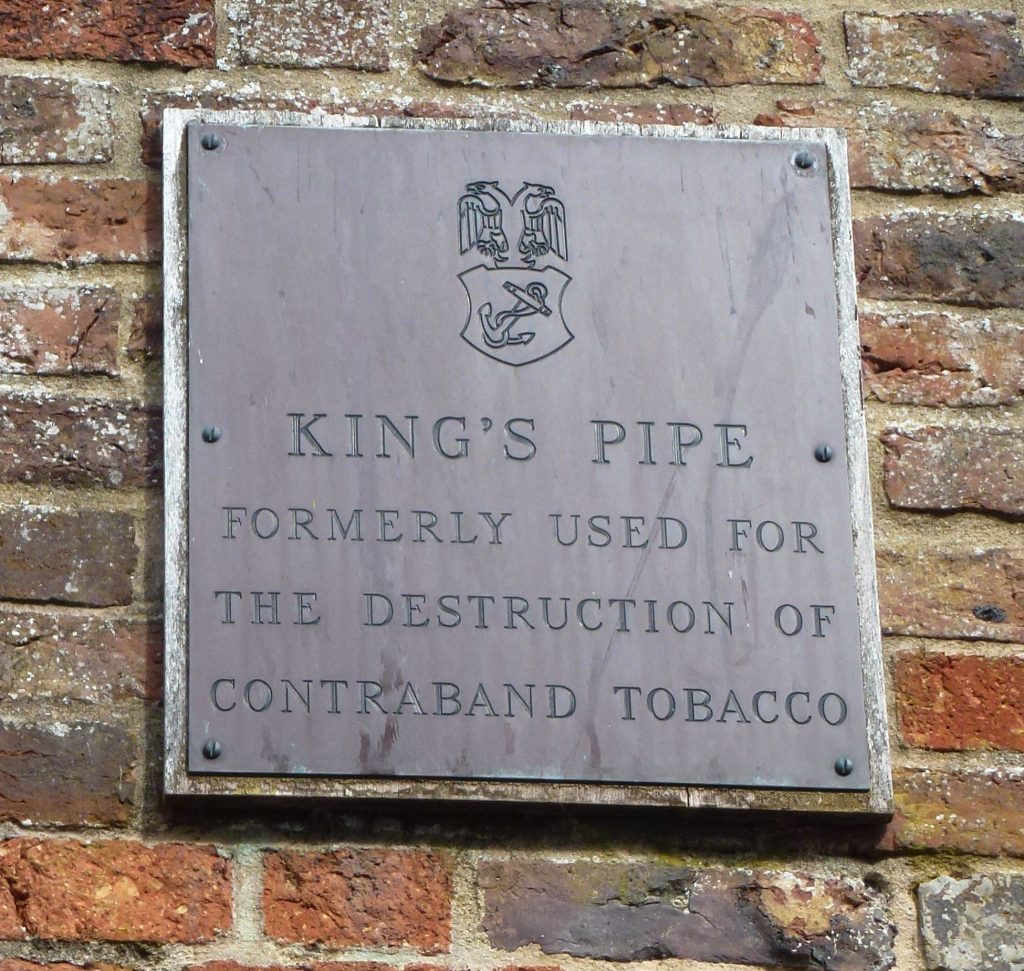
The King’s Pipe, Custom House Quay ©LM Vosper
The King’s Pipe is a Grade II Listed Building, listed by Historic England on 23 January 1973 as an incinerator for destroying contraband tobacco c1814 (the date of the associated Custom House). It is a three-stage brick flue on a granite ashlar plinth on a shallow battened base and the furnace would have been approached from within the courtyard walls of the Custom House.
The Falmouth King’s Pipe sits at the head of the 17th century quay, attached to the back of the 19th century Custom House and is a rare survivor of many that existed in England’s port cities. Most local histories of Falmouth lump it together with the Custom House built in 1814. However, Maritime Historian, Sam Willis, in an interesting article in the Journal of Maritime Archaeology, Vol 4, June 2009 entitled “The Archaeology of Smuggling and the Falmouth King’s Pipe”, argues that a date of 1730-1750 is more realistic. Smuggling became a capital offence in 1746 and he focuses on the requirement that the seized tobacco was burned in public and argues that seeing the pipe working would be a public deterrent. The position of the pipe would have sent a strong message to the maritime community as it can be seen by users of the quay, from the harbour, and from Flushing populated by Packet Captains who were known to have been involved with smuggling.
Read Part 2 of this blog post here.
The Bartlett Blog is written and produced by the volunteers who staff The Bartlett Maritime Research Centre & Library of National Maritime Museum Cornwall. Falmouth Harbour’s Monuments and Memorials – Part 1 was written by Lynne Vosper, a Bartlett Library volunteer.
The Bartlett Maritime Research Centre & Library holds a Collection of over 20,000 volumes and offers access to one of the finest collections of maritime reference books, periodicals and archival material. The Bartlett Blog reflects the diversity of material available in The Bartlett Library.

National Maritime
Museum Cornwall Trust
Discovery Quay
Falmouth Cornwall
TR11 3QY
View Map
See our opening hours
Tel: +44(0)1326 313388
Email: enquiries@nmmc.co.uk